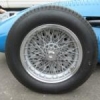Yesterday I went to a very British event, the VSCC Pomeroy Trophy. It is a handicap driving test competition designed to give old and new cars an even chance .
Being the Vintage Sportscar Club there were several pre-1930 cars, the ones with OHC usually had bevel gear cam drives. I think the RR Merlin used bevel drive.
Bevels were replaced by chains then gear drives. Chains are noisy, stretch and need an oil tight box at the front of the engine. Bevel drives have separate oil boxes and no oil filled drive tower to leak. Gear drives don't stretch but setting up backlash is very tricky and harmonics can wreck them as Cosworth found with the DFV.
So why were bevel drives superseded, was it just less engine length or are two bevels sets plus a shaft more expensive than a chain plus two straight gears?
Then , of course Glas introduced the rubber belt drive with no oil and easy replacement – yes I know it is elastomer not rubber but everybody says “rubber”
Having got back from the VSCC I was reading about the recent Ford B-I-O cam drive. B-I-O is "belt in oil" so Ford have replaced a simple rubber belt outside the wet engine area and accessible under a plastic cover with a rubber belt inside the wet engine and very inaccessible. The article was implying a lot of the Ford B-I-O engines have failed simply because the normal wear mode for a rubber drive belt is to shed rubber teeth particles which then go into the sump and neatly block oil filters etc.
Why is B-I-O better thana belt please?
Edited by mariner, 18 February 2024 - 11:26.

















